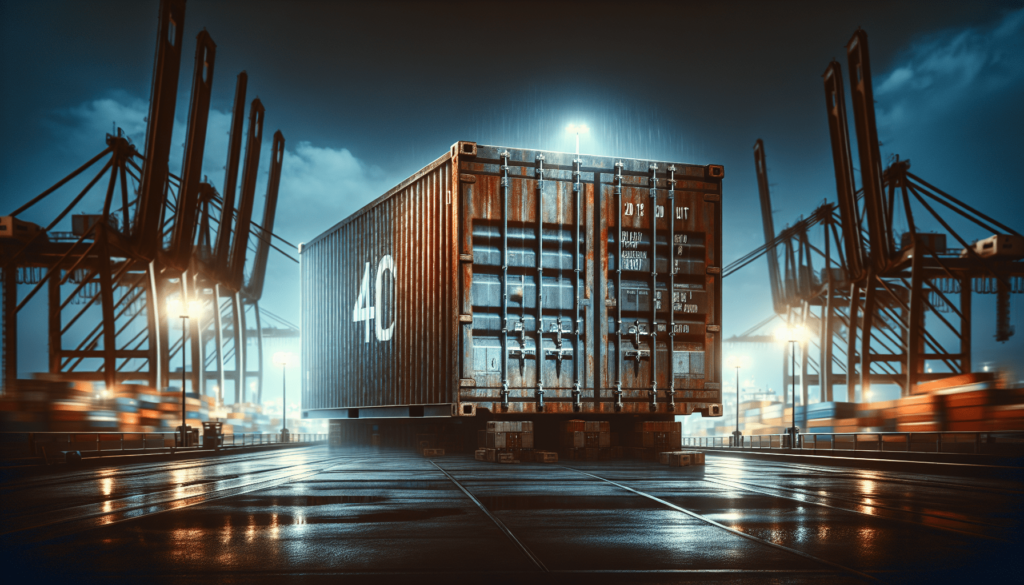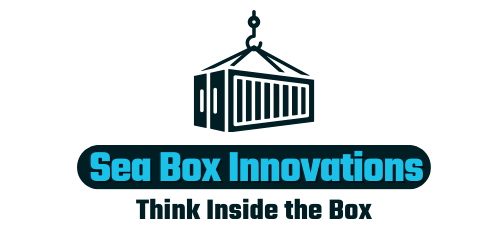Are you wondering about the cost of a 40 ft ocean container? Look no further! In this article, we will explore the price range for these containers, giving you an idea of how much you can expect to pay. Whether you’re a business owner in need of shipping or someone looking to convert a container into a unique living space, knowing the average cost will help you plan accordingly. So, let’s dive right in and discover the fascinating world of 40 ft ocean containers and their pricing!
Factors Affecting the Cost
When determining the cost of a 40 ft ocean container, there are several factors that come into play. These factors can significantly impact the price you will need to pay. It is important to consider these factors before making a decision, as they can make a significant difference in your budget.
Type of Container
The type of container you choose will have a direct impact on the cost. There are different types of containers available, including standard dry containers, refrigerated containers, and open-top containers. Each type of container has its own specifications and purpose, and therefore, the prices can vary. It is crucial to carefully consider your specific needs and choose the type of container that suits them best.
Condition of the Container
Another important factor that affects the cost of a 40 ft ocean container is its condition. Containers can be classified as new or used, and this classification can significantly impact the price. New containers are generally more expensive due to their pristine condition and minimal wear and tear. On the other hand, used containers may have visible signs of use and require some maintenance. Therefore, considering the condition of the container is essential when calculating the overall cost.
Location
The location where you are purchasing the container can also affect the price. Different regions may have varying costs associated with purchasing or renting a 40 ft ocean container. Factors such as local demand, availability, and shipping costs to the desired location can influence the final price. It is advisable to research the prices in your specific location to make an informed decision.
Supplier
The choice of supplier is another important factor that can impact the cost of a 40 ft ocean container. Different suppliers may offer varying prices depending on their overhead costs, reputation, and quality of products. It is crucial to choose a reliable and reputable supplier who can provide you with the desired container at a competitive price. Researching and comparing different suppliers can help you find the best deal.
New Container Price
If you decide to purchase a new 40 ft ocean container, there are a few factors to consider that will determine the price you can expect to pay.
Specification
The specifications of the container, such as its design, material, and features, can significantly impact the price. Containers with special modifications or additional features may cost more than standard ones. It is important to determine your specific requirements and choose a container with the necessary specifications to meet your needs while considering the associated price.
Average Price
The average price for a new 40 ft ocean container can vary depending on the factors discussed earlier. On average, you can expect to pay between $3,000 to $5,000 for a new container. However, keep in mind that prices can fluctuate based on market conditions and other factors.

Used Container Price
If you are considering purchasing a used 40 ft ocean container, there are a few factors to take into account that will affect the price.
Age
The age of a used container is an essential factor to consider when calculating its price. As a general rule, older containers are likely to be less expensive compared to newer ones. However, it is important to also consider the condition of the container, as older containers may require more maintenance and repairs.
Condition
The condition of a used container is crucial in determining its price. Containers in good condition with minimal signs of wear and tear will generally be more expensive than those in poorer condition. It is advisable to carefully inspect the container and consider any necessary repairs or refurbishments when determining its value.
Average Price
The average price for a used 40 ft ocean container can vary significantly depending on its age, condition, and market demand. On average, you can expect to pay between $1,500 to $3,000 for a used container. However, it is important to keep in mind that prices can vary based on the specific circumstances and location.
Additional Costs
When purchasing a 40 ft ocean container, it is essential to consider additional costs that may arise, as they can significantly impact your overall budget.
Transportation
Transportation costs can vary depending on the distance and complexity of the delivery. If the container needs to be transported to a remote location or if there are logistical challenges involved, the transportation costs may be higher. It is crucial to consider these costs and factor them into your budget.
Customs Fees
When dealing with international shipping, it is important to note that customs fees may be applicable. These fees can vary depending on the country and the specific customs regulations in place. It is advisable to research the customs fees associated with the country of importation and consider them when calculating the total cost.
Insurance
To protect your investment, it is recommended to consider insurance for your 40 ft ocean container. Insurance costs can vary depending on the value of the container, its contents, and the coverage options you choose. It is important to obtain insurance quotes and factor these costs into your budget to ensure adequate protection.

Renting vs Buying
In addition to purchasing a 40 ft ocean container, another option to consider is renting. Renting can be a viable alternative in certain situations, and it is important to weigh the pros and cons before making a decision.
Short-term Renting
Short-term renting is a good option if you only require a container for a temporary period. Whether it is for a specific project or a short-term storage solution, renting allows you to utilize a container without the commitment of ownership. Short-term rental prices can vary depending on the duration and location, so it is advisable to compare prices and choose the most cost-effective option.
Long-term Renting
For extended periods of use, long-term renting can be a suitable choice. This option provides flexibility and avoids the upfront costs associated with purchasing a container. Long-term rental prices are usually lower compared to short-term rentals, making it a preferred option for businesses or individuals who require a container for an extended period.
Buying
If you have a long-term need for a 40 ft ocean container or have specific customization requirements, buying may be the best option. By purchasing a container, you have complete ownership and control over its use. However, it is important to consider the total cost of ownership, including maintenance and potential resale value.
Considerations for Buying
When considering buying a 40 ft ocean container, there are a few factors to keep in mind that can affect your decision.
Purchase Price
The purchase price of a container is an obvious consideration when buying. It is crucial to compare prices from different suppliers and ensure that the price aligns with the container’s specifications and condition. Considering the factors mentioned earlier, such as the type of container and its condition, will help you determine a fair purchase price.
Maintenance Costs
Owning a container requires ongoing maintenance to ensure its longevity and functionality. It is important to consider the potential maintenance costs and factor them into your budget. Regular inspections, repairs, and general upkeep can add to the overall cost of ownership.
Resale Value
Even if you plan on purchasing a container for long-term use, it is essential to consider its potential resale value. Circumstances may change, and you may need to sell the container at a later date. Containers in good condition and with desirable specifications can have a higher resale value. It is advisable to choose a container that has good market demand and a better chance of retaining its value over time.
Considerations for Renting
If you are considering renting a 40 ft ocean container, there are a few factors to take into account that can help you make an informed decision.
Rental Charges
The rental charges for a 40 ft ocean container can vary depending on the type of container, its condition, and the duration of the rental period. It is crucial to compare rental charges from different suppliers and choose the option that offers the best value for your specific requirements.
Duration
The duration of your rental period will impact the overall rental cost. Whether you need the container for a few days, weeks, months, or even years, it is important to consider the rental charges and negotiate the duration accordingly. Some suppliers may offer discounts for longer rental periods, so it is worth exploring this option.
Availability
Availability is another consideration when renting a container. It is advisable to check the availability of the desired container type and condition with various suppliers. Depending on the region and demand, certain containers may be in short supply. Planning ahead and securing a rental in advance can help ensure availability when needed.
Comparison of Prices
To make an informed decision about purchasing or renting a 40 ft ocean container, it is important to compare prices from different suppliers.
Local Suppliers
Local suppliers can offer competitive prices due to the proximity of their operations. It is recommended to research and contact local suppliers to obtain quotes and compare their prices. Local suppliers may also provide additional support and after-sales services, which can add value to your purchase or rental.
International Suppliers
While local suppliers may be a good option, it is also worthwhile to consider international suppliers. Global competition and access to a wider market can sometimes result in more competitive prices. However, it is important to consider the potential impact of shipping and customs fees when comparing prices from international suppliers.
Tips for Negotiating Prices
When it comes to purchasing or renting a 40 ft ocean container, negotiation can play a key role in obtaining a favorable price. Consider the following tips when negotiating with suppliers:
Research Market Prices
Before entering into negotiations, it is important to research the current market prices for 40 ft ocean containers. Having a clear understanding of the average prices will help you determine a fair offer during the negotiation process.
Ask for Quotes
Don’t hesitate to request quotes from multiple suppliers. By obtaining quotes from different sources, you can compare prices and identify any significant differences. This will provide you with leverage during negotiations and help ensure you are getting the best possible price.
Negotiate Terms and Conditions
Price negotiation is not limited to the purchase or rental cost alone. It is also important to negotiate favorable terms and conditions. Discuss aspects such as warranty periods, return policies, maintenance responsibilities, and any additional value-added services. By negotiating these factors, you may be able to secure a better overall deal.
Conclusion
When considering the cost of a 40 ft ocean container, it is essential to take into account various factors such as the type of container, its condition, the location, and the supplier. New and used containers have different price ranges based on their specifications and age. Additional costs, such as transportation, customs fees, and insurance, should also be considered. The decision between buying and renting depends on factors such as the duration of use, customization needs, and flexibility requirements. Comparing prices from local and international suppliers, as well as negotiating effectively, can help you secure a container at a competitive price. By carefully considering these factors and following the outlined tips, you can make an informed decision and find the most cost-effective solution for your needs.

I am James, the creator behind SeaBoxInnovations.com. Welcome to our premier online destination dedicated to the world of sea containers. Think Inside the Box is our tagline, and our website is your go-to source for exploring the endless potential of these versatile and adaptable containers. Whether you’re interested in purchasing, customizing, or learning about the latest trends in container architecture and design, we have you covered. Join us as we bridge the gap between traditional uses and cutting-edge applications, promoting sustainability and innovation in design and construction. Get ready to embark on your next big project with SeaBoxInnovations.com.

